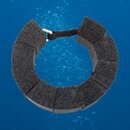smellzlikefish
Contributor
I have been experiencing some elbow pain that I believe is associated with my T1i/Ikelite underwater camera system which is pretty heavy both in and out of the water. Someone on another forum suggested that attaching floats to make the camera more buoyant would help with these aches. I'd love to see some ideas on how/what kind of floats some of you have tried.






